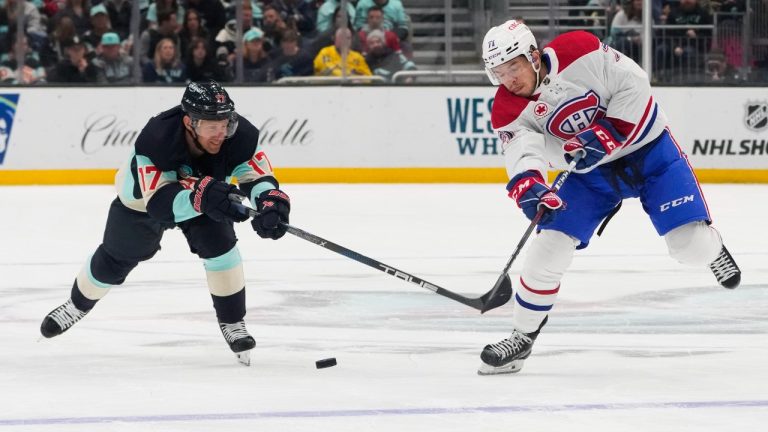BROSSARD, Que. — If the Montreal Canadiens are looking to spend less time in their own zone — and they should be, considering they’re giving up more scoring chances per game than any other team in the league so far this season — one of their lines is providing a template the rest should follow.
Josh Anderson, Brendan Gallagher and Jake Evans play a simple, hard game. They rarely force plays coming up the ice and almost never do in the offensive zone. They’re willing to get the puck in deep and establish a hard forecheck and punishing cycle game.
If the other lines start doing the same, the Canadiens will avoid the type of chaos we’ve seen in their own zone to start this season.
They know.
“I feel like when we spend a lot of time in our zone, it’s not because the other team went 200 feet and just broke us apart,” said Canadiens coach Martin St. Louis after Wednesday’s practice. “It’s usually because we mis-execute at the blue line or tried something that wasn’t there, and then you start the other team’s offence, and then you can’t breathe, you constantly have to go get pucks under pressure in our own end and our Ds get pounded …
“We talk a lot about having a deep-game mentality, and that doesn’t mean that you don’t make plays at the blue line. But it’s gotta be calculated. I feel that has to be a big part of our thoughts as a group. It’s not going to guarantee winning, but it’s going to raise the percentage of winning.”
It’s something the Canadiens learned over the last two-and-a-half seasons under St. Louis’s watch.
But applying the knowledge from those lessons can still be challenging for the second-youngest team in the NHL.
Still, it’s a bit premature to suggest the Canadiens won’t. Four games into the season, there’s plenty of time for them to show they’ve progressed on this front.
If the Canadiens want to do it quickly, though, borrowing from what Anderson, Evans and Gallagher do can help.
As Evans put it ahead of Monday’s 6-3 loss to the Pittsburgh Penguins, “We’re just a line that’s annoying to play against.”
“I think ‘annoying’ is the right word,” he continued, “because we’re pretty straightforward and hard on the forecheck.”
Evans also pointed out on Tuesday that being straightforward coming up the ice also plays a big role in the effectiveness of his line and that the Canadiens can also take something from that.
“Every line’s got their own identity,” he said, “but I guess at some points of the game, when teams are hemming you into the D-zone, getting back to a little simpler way of hockey and just getting it out and feeling better about yourself and putting some pressure on the other teams (helps). Everyone’s got their own identities in how things work for them, but sometimes simple hockey is the way to get out of it.”
Mike Matheson emphasized the importance of simplicity as well, when describing what the Canadiens’ A-game looks like.
“I think that the more that we just play boring in our D-zone and neutral zone and just get it in the offensive zone, the rest takes care of itself,” he said. “I think two out of the three zones can be boring, and then you let your skill and ability take over in the offensive zone.”
You’re seeing the Evans line live by that.
Despite starting less than 28 per cent of their shifts in the offensive zone, they’ve generated 15 scoring chances and allowed just 10 at five-on-five. They’ve also had eight high-danger shot attempts and given up just four, according to naturalstattrick.com.
The line’s style is clearly at the root of that.
The other lines should be trying to copy it as much as they can without straying too much from their own identities.
It won’t necessarily solve all the Canadiens’ defensive issues. They will still need to do a better job of sorting out coverage and employing their hybrid defensive scheme with more efficiency when the puck is in their end.
But the puck will be in their end a lot less if they commit to playing the deep game St. Louis is referring to. The one the Evans line consistently gets to.
Give Dach and Co. time to sort out kinks
In anticipation of Kirby Dach’s first regular-season game in 359 days, we asked his linemates, Alex Newhook and Joel Armia, what we should expect to see from him this season.
“I think he’s got high expectations for himself, and I think we have high expectations for him,” said Newhook of the six-foot-four, 221-pound centreman. “I think he can be a top guy in the league, as well. He’s got that big frame, so he can be one of the better power forwards. He’s kind of got it all. It’s going to be a fun year to watch him.”
“I feel like his ceiling is … I don’t know if there is a ceiling,” said Armia. “I feel like he’s such a good player. He sees the ice well, has good hands, he’s a good skater, he protects the puck well, has the shot — I think he’s the whole package, so I can’t wait to see what he brings.”
He, and everyone else, might have to continue waiting a bit longer.
Not because Dach missed Wednesday’s practice for “a therapy day,” but because the process for him to get back being the player Newhook and Armia described can only naturally be a gradual one after what he’s been through.
Dach played only four periods last season before suffering tears to the ACL and MCL of his right knee in the fifth period. The idea that he could pick up right from where he left off after reconstructive surgery and a long layoff was farfetched, no matter how much promise he possesses as a player.
As St. Louis noted after Monday’s game, no amount of training, practice or pre-season play could fully prepare Dach to get his speed, timing and conditioning tuned to regular-season tempo.
“It’s hard to replicate the regular season — playing three games a week and participating in all the practices,” the coach said. “I’m sure as he gets back into the rhythm of a season, he’s going to feel more comfortable on the ice. I think he’s very engaged physically, so I know it’s going to come back for Dacher. I’m not worried.”
St. Louis expanded on that thought Wednesday.
“For Dacher, who’s missed a lot of time, it takes a little time to get his cues back,” he said. “And that’s going to come. It’s going to come with reps, it’s going to come with discussion, it’s going to come with video and examples in the video room, and we’re just to lead him towards that.
“But, honestly, Dacher is working. Like his effort. He’s finishing checks. I just watched his game — he’s engaged physically tremendously, and for us it’s just getting him to a point where the game is easier. When it’s easier, that’s when you’re playing the game.”
Dach’s linemates can help him get to it, too.
Newhook has the speed to push opposing defenders back. Armia, who’s often referred to as “House” by his teammates, has the power and intelligence to facilitate puck possession and extend offensive-zone time. And both players need to activate those strengths more frequently to allow Dach to consistently deliver what he’s capable of.
We know that, as a line, they have more to give, with the underlying numbers showing they haven’t been at the level they expect from themselves.
Newhook, Dach and Armia have played 23:34 together at five-on-five, and they’ve controlled only 32 per cent of the shot attempts and 33 per cent of the expected goals, and they’ve been outscored 3-0. And that’s despite the benefit of starting 46 per cent of their shifts in the offensive zone.
They know they can be a lot better, and they’re going to have to be for the Canadiens to succeed.
Dach figures to be at the root of the line’s improvement, and you know he’ll be challenging himself to be exactly that come Thursday against the Los Angeles Kings.
He has stressed the importance of being patient with himself, of giving himself the necessary time to be the player he expects to be after going through something similar with a wrist injury earlier in his career.
But Dach’s patience will be tested, especially given how competitive he is by nature.
He’s aware that his performance — and that of his line — is a discussion point around Montreal right now, and he’s shown he’s the type of player who embraces being challenged.
We’ve seen a bit of attitude in Dach’s game since he arrived in Montreal as a highly scrutinized player who was drafted third overall in 2019 and who fell short of sky-high expectations with the Chicago Blackhawks.
Gallagher has seen it, too.
“That’s probably something you don’t really know about him unless you spend a little bit of time around him: he’s competitive, he doesn’t back down,” Gallagher said. “You’ll see him put in the work, you’ll see him put in the time, and that’s what you need in when you’re in that situation. It’s a long injury to come back from, and then the amount of time he spent away from the game is something.
“But to have that competitive motivation factor is going to be important for him.”
Newhook said he feels it has kicked in for his centreman.
He thinks Dach’s game is coming.
Gallagher believes it’s improving too, and says that, when it fully arrives, it will make a big difference for the Canadiens.
“We’ve seen him at his best, and he’s a guy that can carry a team for stretches at a time,” Gallagher said. “We know how good he is, it’s just a matter of being patient right now and helping feel a bit more comfortable. We’ve all come back from injuries, and his was a really traumatic one and a long one to be coming back from. It definitely takes time.”





 0:59
0:59
